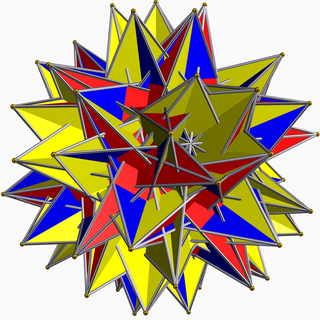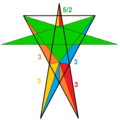From Wikipedia, the free encyclopedia
Uniform star polyhedron
3D model of a great retrosnub icosidodecahedron In geometry , the great retrosnub icosidodecahedron or great inverted retrosnub icosidodecahedron is a nonconvex uniform polyhedron , indexed as U74 . It has 92 faces (80 triangles and 12 pentagrams ), 150 edges, and 60 vertices.[1] Schläfli symbol sr{3 ⁄2 5 ⁄3
Cartesian coordinates [ edit ] Cartesian coordinates for the vertices of a great retrosnub icosidodecahedron are all the even permutations of
(
±
2
α
,
±
2
,
±
2
β
)
,
(
±
[
α
−
β
φ
−
1
φ
]
,
±
[
α
φ
+
β
−
φ
]
,
±
[
−
α
φ
−
β
φ
−
1
]
)
,
(
±
[
α
φ
−
β
φ
+
1
]
,
±
[
−
α
−
β
φ
+
1
φ
]
,
±
[
−
α
φ
+
β
+
φ
]
)
,
(
±
[
α
φ
−
β
φ
−
1
]
,
±
[
α
+
β
φ
+
1
φ
]
,
±
[
−
α
φ
+
β
−
φ
]
)
,
(
±
[
α
−
β
φ
+
1
φ
]
,
±
[
−
α
φ
−
β
−
φ
]
,
±
[
−
α
φ
−
β
φ
+
1
]
)
,
{\displaystyle {\begin{array}{crrrc}{\Bigl (}&\pm \,2\alpha ,&\pm \,2,&\pm \,2\beta &{\Bigr )},\\{\Bigl (}&\pm {\bigl [}\alpha -\beta \varphi -{\frac {1}{\varphi }}{\bigr ]},&\pm {\bigl [}{\frac {\alpha }{\varphi }}+\beta -\varphi {\bigr ]},&\pm {\bigl [}-\alpha \varphi -{\frac {\beta }{\varphi }}-1{\bigr ]}&{\Bigr )},\\{\Bigl (}&\pm {\bigl [}\alpha \varphi -{\frac {\beta }{\varphi }}+1{\bigr ]},&\pm {\bigl [}-\alpha -\beta \varphi +{\frac {1}{\varphi }}{\bigr ]},&\pm {\bigl [}-{\frac {\alpha }{\varphi }}+\beta +\varphi {\bigr ]}&{\Bigr )},\\{\Bigl (}&\pm {\bigl [}\alpha \varphi -{\frac {\beta }{\varphi }}-1{\bigr ]},&\pm {\bigl [}\alpha +\beta \varphi +{\frac {1}{\varphi }}{\bigr ]},&\pm {\bigl [}-{\frac {\alpha }{\varphi }}+\beta -\varphi {\bigr ]}&{\Bigr )},\\{\Bigl (}&\pm {\bigl [}\alpha -\beta \varphi +{\frac {1}{\varphi }}{\bigr ]},&\pm {\bigl [}-{\frac {\alpha }{\varphi }}-\beta -\varphi {\bigr ]},&\pm {\bigl [}-\alpha \varphi -{\frac {\beta }{\varphi }}+1{\bigr ]}&{\Bigr )},\\\end{array}}}
with an even number of plus signs, where
α
=
ξ
−
1
ξ
,
β
=
−
ξ
φ
+
1
φ
2
−
1
ξ
φ
,
{\displaystyle {\begin{aligned}\alpha &=\xi -{\frac {1}{\xi }},\\[4pt]\beta &=-{\frac {\xi }{\varphi }}+{\frac {1}{\varphi ^{2}}}-{\frac {1}{\xi \varphi }},\end{aligned}}}
where
φ
=
1
+
5
2
{\displaystyle \varphi ={\tfrac {1+{\sqrt {5}}}{2}}}
golden ratio and
ξ is the smaller positive real root of
ξ
3
−
2
ξ
=
−
1
φ
⟹
ξ
=
(
1
+
i
3
)
1
2
φ
+
1
4
φ
2
−
8
27
3
+
(
1
−
i
3
)
1
2
φ
−
1
4
φ
2
−
8
27
3
2
≈
0.3264046
{\displaystyle {\begin{aligned}\xi ^{3}-2\xi =-{\frac {1}{\varphi }}\quad \implies \quad \xi &={\frac {\left(1+i{\sqrt {3}}\right){\sqrt[{3}]{{\frac {1}{2\varphi }}+{\sqrt {{\frac {1}{4\varphi ^{2}}}-{\frac {8}{27}}}}}}+\left(1-i{\sqrt {3}}\right){\sqrt[{3}]{{\frac {1}{2\varphi }}-{\sqrt {{\frac {1}{4\varphi ^{2}}}-{\frac {8}{27}}}}}}}{2}}\\[4pt]&\approx 0.3264046\end{aligned}}}
Taking the odd permutations of the above coordinates with an odd number of plus signs gives another form, the enantiomorph of the other one. Taking the odd permutations with an even number of plus signs or vice versa results in the same two figures rotated by 90 degrees.
The circumradius for unit edge length is
R
=
1
2
2
−
x
1
−
x
=
0.580002
…
{\displaystyle R={\frac {1}{2}}{\sqrt {\frac {2-x}{1-x}}}=0.580002\dots }
where
x is the appropriate root of
x
3
+
2
x
2
=
(
1
±
5
2
)
2
.
{\displaystyle x^{3}+2x^{2}={\Big (}{\tfrac {1\pm {\sqrt {5}}}{2}}{\Big )}^{2}.}
The four positive real roots of the
sextic in
R 2 ,
4096
R
12
−
27648
R
10
+
47104
R
8
−
35776
R
6
+
13872
R
4
−
2696
R
2
+
209
=
0
{\displaystyle 4096R^{12}-27648R^{10}+47104R^{8}-35776R^{6}+13872R^{4}-2696R^{2}+209=0}
are the circumradii of the
snub dodecahedron (U
29 ),
great snub icosidodecahedron (U
57 ),
great inverted snub icosidodecahedron (U
69 ), and great retrosnub icosidodecahedron (U
74 ).
See also [ edit ] References [ edit ] External links [ edit ]




![{\displaystyle {\begin{array}{crrrc}{\Bigl (}&\pm \,2\alpha ,&\pm \,2,&\pm \,2\beta &{\Bigr )},\\{\Bigl (}&\pm {\bigl [}\alpha -\beta \varphi -{\frac {1}{\varphi }}{\bigr ]},&\pm {\bigl [}{\frac {\alpha }{\varphi }}+\beta -\varphi {\bigr ]},&\pm {\bigl [}-\alpha \varphi -{\frac {\beta }{\varphi }}-1{\bigr ]}&{\Bigr )},\\{\Bigl (}&\pm {\bigl [}\alpha \varphi -{\frac {\beta }{\varphi }}+1{\bigr ]},&\pm {\bigl [}-\alpha -\beta \varphi +{\frac {1}{\varphi }}{\bigr ]},&\pm {\bigl [}-{\frac {\alpha }{\varphi }}+\beta +\varphi {\bigr ]}&{\Bigr )},\\{\Bigl (}&\pm {\bigl [}\alpha \varphi -{\frac {\beta }{\varphi }}-1{\bigr ]},&\pm {\bigl [}\alpha +\beta \varphi +{\frac {1}{\varphi }}{\bigr ]},&\pm {\bigl [}-{\frac {\alpha }{\varphi }}+\beta -\varphi {\bigr ]}&{\Bigr )},\\{\Bigl (}&\pm {\bigl [}\alpha -\beta \varphi +{\frac {1}{\varphi }}{\bigr ]},&\pm {\bigl [}-{\frac {\alpha }{\varphi }}-\beta -\varphi {\bigr ]},&\pm {\bigl [}-\alpha \varphi -{\frac {\beta }{\varphi }}+1{\bigr ]}&{\Bigr )},\\\end{array}}}](https://wikimedia.org/api/rest_v1/media/math/render/svg/4f7e1b1ee5692b0155448d8f632b2ffab5088df1)
![{\displaystyle {\begin{aligned}\alpha &=\xi -{\frac {1}{\xi }},\\[4pt]\beta &=-{\frac {\xi }{\varphi }}+{\frac {1}{\varphi ^{2}}}-{\frac {1}{\xi \varphi }},\end{aligned}}}](https://wikimedia.org/api/rest_v1/media/math/render/svg/7e6a3e86c3eab5801ad1f161516d1c4927862671)

![{\displaystyle {\begin{aligned}\xi ^{3}-2\xi =-{\frac {1}{\varphi }}\quad \implies \quad \xi &={\frac {\left(1+i{\sqrt {3}}\right){\sqrt[{3}]{{\frac {1}{2\varphi }}+{\sqrt {{\frac {1}{4\varphi ^{2}}}-{\frac {8}{27}}}}}}+\left(1-i{\sqrt {3}}\right){\sqrt[{3}]{{\frac {1}{2\varphi }}-{\sqrt {{\frac {1}{4\varphi ^{2}}}-{\frac {8}{27}}}}}}}{2}}\\[4pt]&\approx 0.3264046\end{aligned}}}](https://wikimedia.org/api/rest_v1/media/math/render/svg/84f73b4b8a178360ea8037a923d53526e821d4df)


